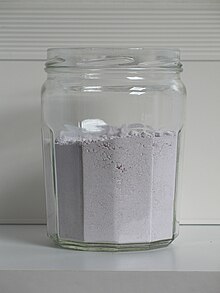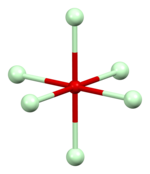
| |

| |
| Names | |
|---|---|
| IUPAC name
Neodymium(III) oxide
| |
| Other names
Neodymium oxide, Neodymium sesquioxide
| |
| Identifiers | |
3D model (JSmol)
|
|
| ChemSpider | |
| ECHA InfoCard | 100.013.832 |
| EC Number |
|
PubChem CID
|
|
| UNII | |
CompTox Dashboard (EPA)
|
|
| |
| |
| Properties | |
| Nd2O3 | |
| Molar mass | 336.48 g/mol |
| Appearance | light bluish gray hexagonal crystals |
| Density | 7.24 g/cm3 |
| Melting point | 2,233 °C (4,051 °F; 2,506 K) |
| Boiling point | 3,760 °C (6,800 °F; 4,030 K)[1] |
| .0003 g/100 mL (75 °C) | |
| +10,200.0·10−6 cm3/mol | |
| Structure | |
| Hexagonal, hP5 | |
| P-3m1, No. 164 | |
| Thermochemistry | |
Heat capacity (C)
|
111.3 J·mol−1·K−1[1] |
Std molar
entropy (S⦵298) |
158.6 J·mol−1·K−1 |
Std enthalpy of
formation (ΔfH⦵298) |
−1807.9 kJ·mol−1 |
| Related compounds | |
Other anions
|
Neodymium(II) chloride Neodymium(III) chloride |
Other cations
|
Uranium(VI) oxide Praseodymium(III) oxide Promethium(III) oxide |
Except where otherwise noted, data are given for materials in their standard state (at 25 °C [77 °F], 100 kPa).
| |
Neodymium(III) oxide or neodymium sesquioxide is the chemical compound composed of neodymium and oxygen with the formula Nd2O3. It forms very light grayish-blue hexagonal crystals.[1] The rare-earth mixture didymium, previously believed to be an element, partially consists of neodymium(III) oxide.[2]
Neodymium(III) oxide is used to dope glass, including sunglasses, to make solid-state lasers, and to color glasses and enamels.[3] Neodymium-doped glass turns purple due to the absorbance of yellow and green light, and is used in welding goggles.[4] Some neodymium-doped glass is dichroic; that is, it changes color depending on the lighting. One kind of glass named for the mineral alexandrite appears blue in sunlight and red in artificial light.[5] About 7000 tonnes of neodymium(III) oxide are produced worldwide each year. Neodymium(III) oxide is also used as a polymerization catalyst.[4]
Neodymium(III) oxide is formed when neodymium(III) nitride or neodymium(III) hydroxide is roasted in air.[6]
Neodymium(III) oxide has a low-temperature trigonal A form in space group P3m1.[7] This structure type is favoured by the early lanthanides.[8][9] At higher temperatures it adopts two other forms, the hexagonal H form in space group P63/mmc and the cubic X form in Im3m. The high-temperature forms exhibit crystallographic disorder.[10][11]
| Packing | Neodymium coordination | Oxygen O1 coordination | Oxygen O2 coordination |
|---|---|---|---|

|

|

|

|
| A-M2O3 structure type | approximately capped octahedral | octahedral | approximately tetrahedral |